

WEEK 13: MARCH 22-28
TOPIC: “SMALL BODIES” AND THE ELECTROMAGNETIC SPECTRUM
The “visible” light that our eyes see, and that most of our telescopes detect, is only a very small part of the electromagnetic spectrum. The full EM spectrum encompasses everything from the long-wavelength, low-frequency, low-energy radio waves, on down through infrared, then “visible” or optical light, and then into the shorter-wavelength, higher-frequency, and higher-energy ultraviolet, x-rays, and gamma-rays. A wide variety of different physical processes and mechanisms contribute towards producing the various forms of EM radiation, for example, radio waves are generally produced by cold molecular gas, infrared is often produced by warmed-up dust re-radiating higher-energy forms of light, and ultraviolet, x-rays, and gamma-rays are usually produced by hot gas and very energetic processes.
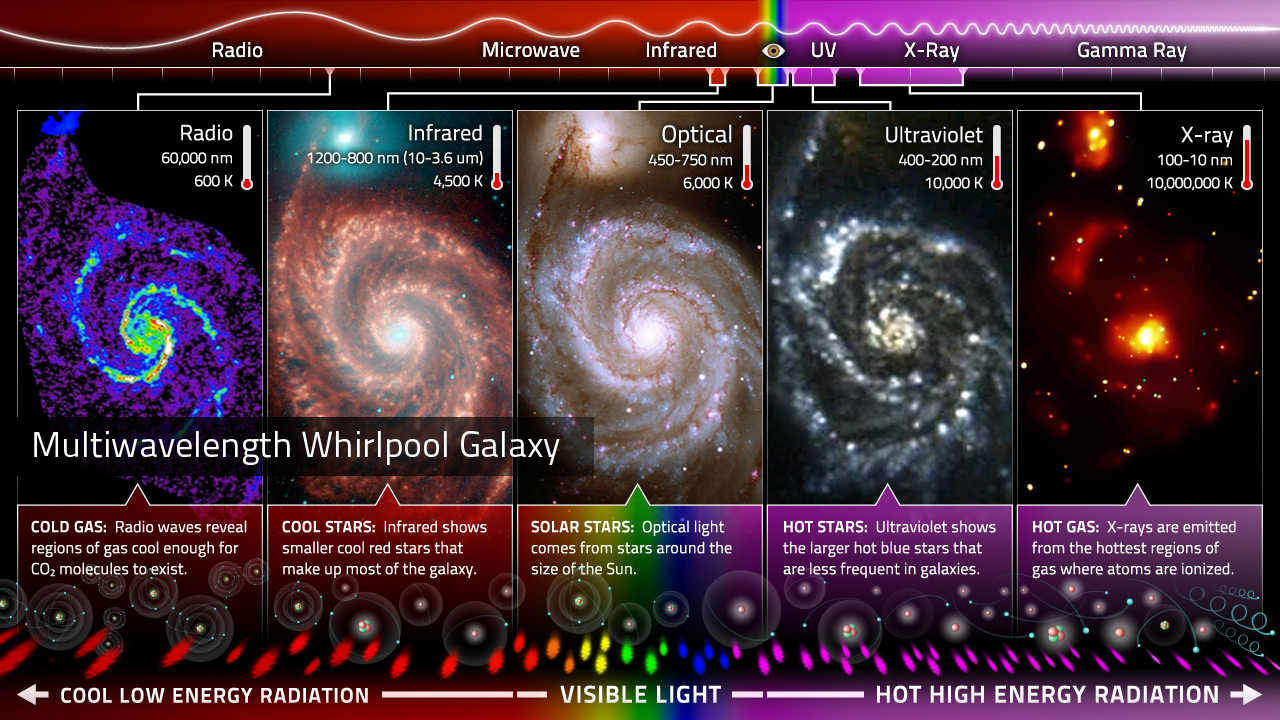 The spiral galaxy M51 in Canes Venatici as images in several regions of the electromagnetic spectrum. The processes that produce the various forms of EM radiation are described under each image. Courtesy NASA/University of Chicago.
The spiral galaxy M51 in Canes Venatici as images in several regions of the electromagnetic spectrum. The processes that produce the various forms of EM radiation are described under each image. Courtesy NASA/University of Chicago.
For most of human history our knowledge of the surrounding universe was restricted to what information we could gather via “visible” light. This gives us, at best, a rather limited view of that universe, with many of the processes that operate in the universe being hidden. The opening up of the various other regions of the EM spectrum over the past several decades has accordingly given us a much more comprehensive and complete picture of the universe and the various processes that operate within it than was ever possible before.
Much of the EM radiation in space is blocked from Earth’s surface by our planet’s atmosphere – which is fortunate for us, especially with the higher-energy forms of radiation like ultraviolet, x-rays, and gamma-rays, since otherwise we wouldn’t be here to appreciate the fact. There are two primary “windows” whereby some EM radiation does reach the surface; one of these is in the optical part of the spectrum, which includes the “visible” light that we see, and which extends slightly into the ultraviolet – enough to produce suntans and sunburns – and partially into the infrared, with some regions being blocked by atmospheric gases and others regions able to reach the ground. (The gases that block some of the infrared include the “greenhouse” gases like carbon dioxide and water vapor, which also prevent surface-produced infrared radiation from escaping into space.)
The other “window” is in the radio region of the spectrum. Radio waves from space were discovered somewhat by accident in 1931 by a Bell Labs engineer, Karl Jansky, who was investigating the source of a “hiss” that appeared in a radio antenna that he had built, and found that it came from the center of our Galaxy in Sagittarius. An American engineer and radio astronomer, Grote Reber, built a radio dish in his backyard in Illinois in 1937, and is generally credited as developing the science of radio astronomy. Today radio astronomy is a very active arena of astronomical investigation, and via the technique of interferometry and large systems of radio telescopes such as the Very Large Array in New Mexico it is possible to achieve extremely high resolution of astronomical objects.
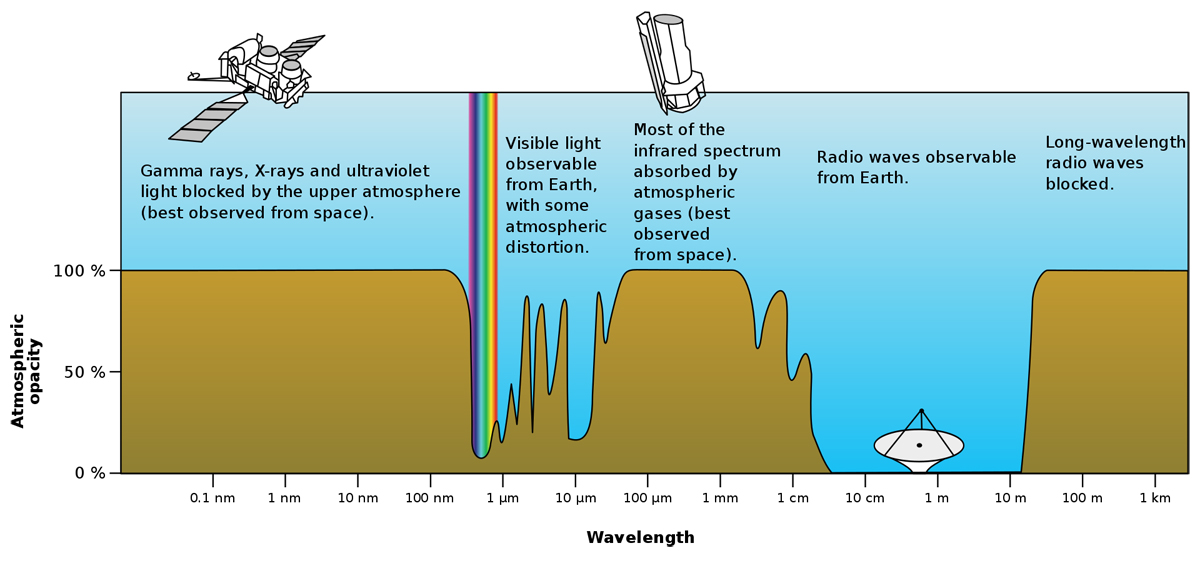 The various “windows” in Earth’s atmosphere that permit some regions of the electromagnetic spectrum to reach the surface.
The various “windows” in Earth’s atmosphere that permit some regions of the electromagnetic spectrum to reach the surface.
Our studies of the other regions of the EM spectrum had to wait until the beginning of the Space Age. As early as the late 1940s sounding rocket flights carried ultraviolet detectors above the atmosphere which allowed for a few minutes of observations, but more intense studies had to wait until the capability of launching satellites into orbit could be achieved. Today almost every region of the EM spectrum has one or more astronomical telescopes in Earth orbit (or occasionally elsewhere) collecting observations on a full-time basis.
As is true for other types of astronomical objects, the “small bodies” of our solar system (and other planetary systems, for that matter) have been examined in all the various regions of the EM spectrum. Since observations in the optical part of the spectrum primarily constitute the observations discussed throughout these “Special Topics” presentations, here I will focus on the other regions of the EM spectrum. To a pretty large degree, the developmental history of “small bodies” observations in these other regions of the spectrum parallels that of most other types of astronomical objects.
The first radio observations of the solar system’s “small bodies” utilized radio waves in an active sense, i.e., radar. A meteor passing through the atmosphere will ionize molecules in the air around it, which in turn leave a radar-detectable echo. The first widespread use of radar took place during World War II, and shortly thereafter several radars of that era, including at Jodrell Bank Observatory in England, were specially adapted for use in detecting meteors, and the first successful usage of this process came with the Draconid meteor shower on October 9, 1946. (The Draconid shower was especially strong that year, with rates peaking at 3000 to 6000 meteors per hour; they are associated with Comet 21P/Giacobini-Zinner, which is a future “Comet of the Week.”)
Radar observations of meteor showers are quite routine nowadays. Indeed, several daytime meteor showers, detectable only via radar, have been discovered over the past few decades; the strongest of these, the Arietids, peaks around June 7 every year and has a peak rate of about 60 meteors per hour.
Radar can also be used to detect objects passing near Earth. This was accomplished for the first time in June 1968 when the near-Earth asteroid (1566) Icarus passed 0.04 AU from Earth; MIT Lincoln Laboratories’ Haystack Radio Observatory in Massachusetts and NASA’s large tracking antenna in Goldstone, California both recorded successful detections. MIT student Paul Kamoun utilized the giant Arecibo radio telescope in Puerto Rico to accomplish the first radar detection of a cometary nucleus, of Comet 2P/Encke in November 1980, and the first radar detection of a long-period comet took place in May 1983 with Comet IRAS-Araki-Alcock 1983d during that object’s close approach to Earth. Today the Arecibo radio telescope and the Goldstone antenna are utilized quite frequently for radar detections of passing asteroids and comets, and have found that a non-trivial percentage of these objects are either binary or at least “contact binary” in structure. Radar has also been utilized for related investigations, for example, the detection of water ice in Mercury’s polar regions that is the likely result of cometary impacts.

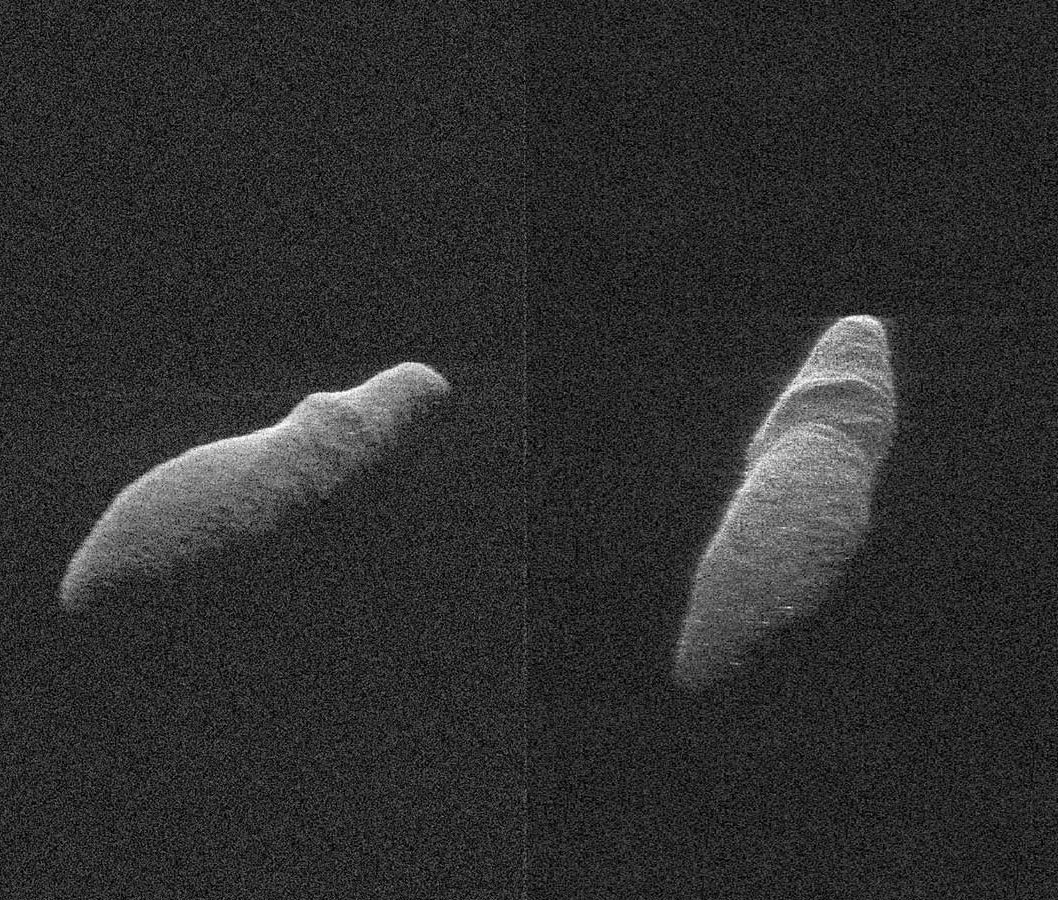 LEFT: The Karl G. Jansky Very Large Array in New Mexico. Courtesy National Radio Astronomy Observatory. RIGHT: Radar images (combined with data from NASA’s tracking antenna in Goldstone, California and the Arecibo radio telescope in Puerto Rico) of the near-Earth asteroid (163899) 2003 SD220 obtained on December 16 and 17, 2018, during that object’s close approach to Earth. Courtesy NASA.
LEFT: The Karl G. Jansky Very Large Array in New Mexico. Courtesy National Radio Astronomy Observatory. RIGHT: Radar images (combined with data from NASA’s tracking antenna in Goldstone, California and the Arecibo radio telescope in Puerto Rico) of the near-Earth asteroid (163899) 2003 SD220 obtained on December 16 and 17, 2018, during that object’s close approach to Earth. Courtesy NASA.
The first radio observations of a comet were made in 1957 of Comet Arend-Roland 1956h (a future “Comet of the Week”), but such was the state of technology at the time that little in the way of scientific observations could be performed other than in the evolution of large-scale phenomena in the comet’s coma and tail. The first useful scientific radio observations of a comet were made in late 1973 of Comet Kohoutek 1973f – also a future “Comet of the Week” – and these revealed the presence of numerous complex molecules, including various organic molecules. The radio observation of comets has expanded greatly since then and is a routine part of cometary investigations today, and numerous substances have now been identified in comets’ comae and tails.
The region of the radio spectrum with wavelengths in the millimeter to centimeter range is usually referred to as the “microwave” part of the EM spectrum, and the region with wavelengths slightly less than one millimeter is usually referred to as the “submillimeter” part of the spectrum; these are sometimes treated as their own respective regions of the EM spectrum. Earth’s atmosphere is rather opaque in this part of the spectrum, although instruments placed at dry high-altitude sites, such as Mauna Kea in Hawaii and Chile’s Atacama Desert, can access these regions to an extent. Sub-millimeter telescopes, in particular, have proven instrumental in demonstrating that sublimation of carbon monoxide plays a significant role in driving cometary activity. The Atacama Large Millimeter/submillimeter Array (ALMA) telescope in Chile has been quite effective in examining the planet-forming – and comet-forming – disks around newborn stars. Meanwhile, the Submillimeter Wave Astronomy Satellite (SWAS) spacecraft, launched in 1998, has been able to examine comets from space in this part of the spectrum, including Comet 9P/Tempel 1 around the time of the Deep Impact encounter in 2005. (This is discussed in that comet’s upcoming “Comet of the Week” presentation.)
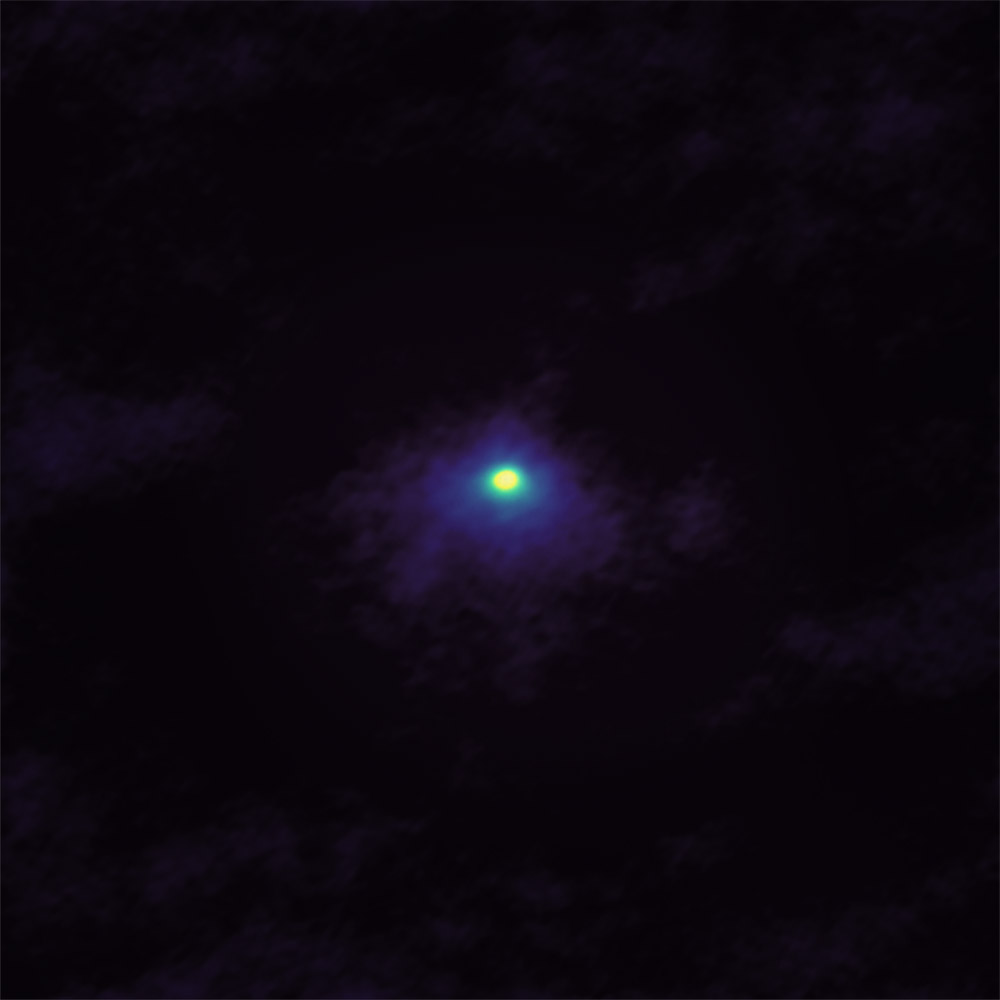
 LEFT: ALMA image of Comet 46P/Wirtanen obtained on December 2, 2018 shortly before that object’s close approach to Earth. Courtesy ALMA/ESO/ NAOJ/NRAO/Martin Cordiner/NASA. RIGHT: Processed ALMA image of the planet-forming (and comet-forming) disk around the young star Oph-IRS 48 in Ophiuchus. Courtesy ALMA/NRAO/Nienke van der Marel.
LEFT: ALMA image of Comet 46P/Wirtanen obtained on December 2, 2018 shortly before that object’s close approach to Earth. Courtesy ALMA/ESO/ NAOJ/NRAO/Martin Cordiner/NASA. RIGHT: Processed ALMA image of the planet-forming (and comet-forming) disk around the young star Oph-IRS 48 in Ophiuchus. Courtesy ALMA/NRAO/Nienke van der Marel.
The dust in comets and asteroids, especially when warmed by sunlight, can produce strong signals in the infrared, and since part of the optical “window” extends into the infrared ground-based infrared observations of these objects has been possible for some time. Carl Lampland at Lowell Observatory in Arizona performed the first infrared observations of a comet as far back as 1927 when he observed the brilliant Comet Skjellerup-Maristany 1927k with an infrared thermocouple; his observations were enough to show that the pre-perihelion infrared emissions were due to reflected sunlight, whereas the post-perihelion emissions were due to heated dust within the nucleus and coma. It would be another four decades before another comet was observed in the infrared, these observations being performed of Comet Ikeya-Seki 1965f – a future “Comet of the Week.” Infrared observations of comets (and asteroids as well) are quite routine nowadays; one of the early results from infrared comet observations was the identification of silicate grains in the coma of Comet Bennett 1969i – next week’s “Comet of the Week” – that are essentially identical to those that have been detected in the atmospheres of red giant stars.
Observations in the mid- and far-infrared require the usage of spacecraft above the atmosphere. All-sky infrared surveys were carried out by the InfraRed Astronomical Satellite (IRAS) mission in 1983 and the Wide-field Infrared Survey Explorer (WISE) spacecraft in 2010; among many other discoveries, IRAS discovered six comets (including the Earth-approaching Comet IRAS-Araki-Alcock 1983d), the “asteroid” (3200) Phaethon (the apparent parent object of the Geminid meteors), and a long dust tail following Comet 10P/Tempel 2, while WISE discovered 17 comets and several near-Earth asteroids, including the first-known (and, so far, only known) Earth “Trojan” asteroid, 2010 TK7. (Trojan asteroids are the subject of a future “Special Topics” presentation.) Although WISE’s two longest-wavelength detectors ceased functioning once its solid hydrogen coolant ran out, its two shorter-wavelength detectors remain operational, and it was reactivated in late 2013 to search for Earth-approaching objects under the mission name Near-Earth Object Wide-field Infrared Survey Explorer (NEOWISE); to date NEOWISE has discovered 17 comets and numerous near-Earth asteroids.
Other infrared space telescopes that have observed “small bodies” include NASA’s Spitzer Space Telescope and ESA’s Herschel Space Observatory (the range of which extended into the far-infrared and submillimeter regions of the EM spectrum). One of Spitzer’s most dramatic observations was the detection of a tail and a coma (apparently produced by sublimation of carbon dioxide) around the “asteroid” (3552) Don Quixote in 2009; this had long been considered a likely “extinct” comet, and the Spitzer observations showed that it is still active at a low level. Meanwhile, the James Webb Space Telescope, currently scheduled for launch in March 2021, will be an infrared-sensitive instrument and will certainly be observing comets and asteroids from time to time.
The first space-based ultraviolet observations of a comet were performed by a sounding rocket launched from White Sands Missile Range in New Mexico of Comet Ikeya-Seki 1965f, although little in the way of useful scientific results came from these. Sounding rockets remain a relatively inexpensive (albeit brief) means of obtaining ultraviolet observations from space, and various other comets have been so observed since then; I had the privilege of witnessing a couple of sounding rocket launches from White Sands to study Comet Hale-Bopp in 1997.

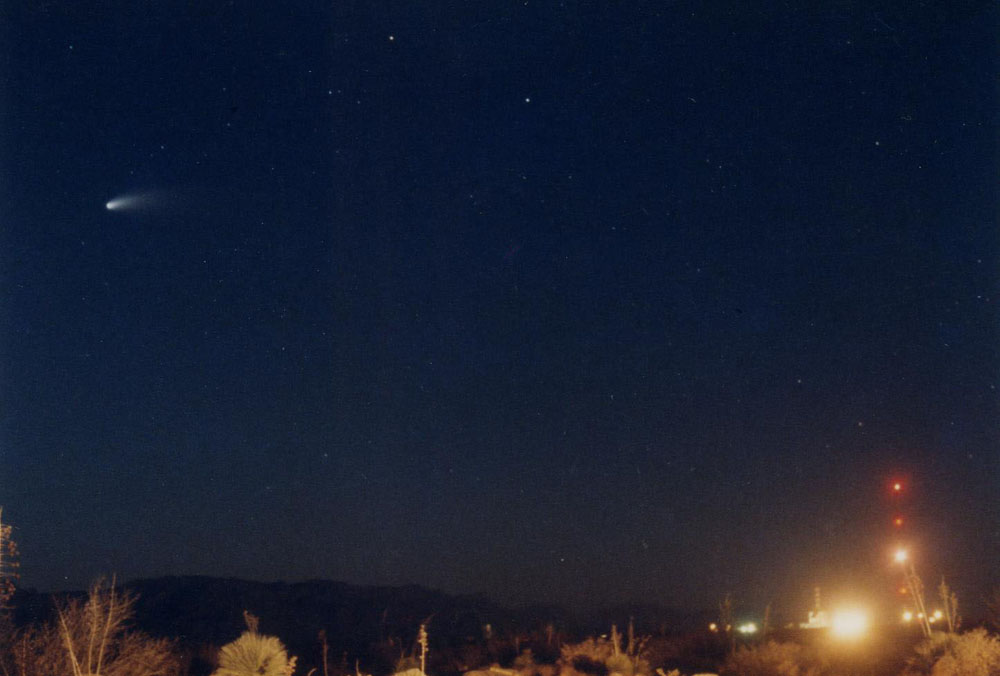 LEFT: Composite image (wavelength 24 microns) of the components of the split Comet 73P/Schwassmann-Wachmann 3, obtained by the Spitzer Space Telescope between May 4 and 6, 2006. The image shows several distinct components as well as a string of dusty debris between them. Image courtesy NASA. RIGHT: I took this photograph of Comet Hale-Bopp and Launch Complex 36 at White Sands Missile Range, New Mexico, shortly before the launch of a sounding rocket on the evening of March 24, 1997. The desert landscape is lit up by the nearly full moon.
LEFT: Composite image (wavelength 24 microns) of the components of the split Comet 73P/Schwassmann-Wachmann 3, obtained by the Spitzer Space Telescope between May 4 and 6, 2006. The image shows several distinct components as well as a string of dusty debris between them. Image courtesy NASA. RIGHT: I took this photograph of Comet Hale-Bopp and Launch Complex 36 at White Sands Missile Range, New Mexico, shortly before the launch of a sounding rocket on the evening of March 24, 1997. The desert landscape is lit up by the nearly full moon.
The first ultraviolet observations of comets from orbit came in early 1970 when the Orbiting Astronomical Observatory 2 (OAO-2) satellite detected a large cloud of hydrogen surrounding Comet Tago-Sato-Kosaka 1969g (a previous “Comet of the Week”); the existence of such a cloud had been predicted a few years earlier by the German astronomer Ludwig Biermann. OAO-2 detected a similar, larger cloud around Comet Bennett 1969i a couple of months later; the Orbiting Geophysical Observatory 5 (OGO-5) satellite also detected this cloud around Comet Bennett and also a smaller cloud around Comet 2P/Encke late that year. These “Lyman-alpha clouds” – so named due to the strongest ultraviolet spectral line of hydrogen – are now known to accompany almost all comets that visit the inner solar system, and the ultraviolet-sensitive Solar Wind ANisotropies (SWAN) telescope aboard the joint NASA/ESA SOlar and Heliospheric Observatory (SOHO) spacecraft routinely detects them. Several researchers scan the publicly-accessible SWAN images in search of previously-unknown comets, and to date 16 comets have been so discovered, all but the first two of these being near-real-time discoveries.
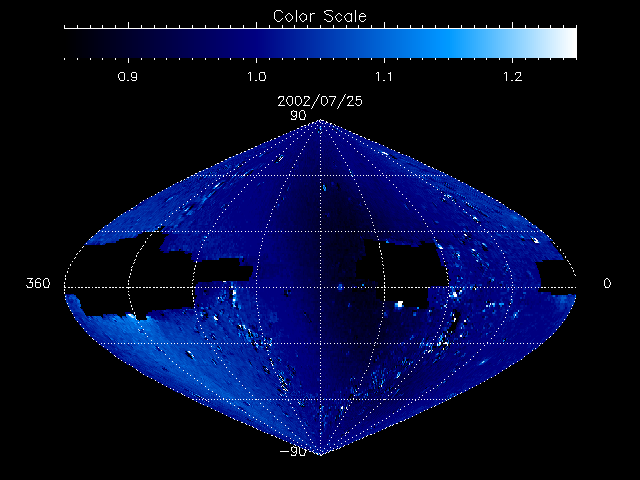
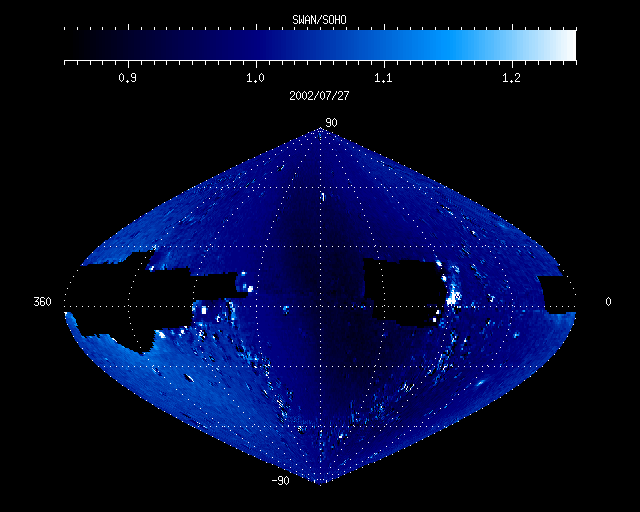 All-sky images taken by the SWAN ultraviolet telescope aboard the SOHO spacecraft on July 25 (left) and 27 (right), 2002. These are the discovery images of Comet SWAN C/2002 06; the comet is the bright, diffuse, moving object in the lower right quadrant of the images. Courtesy NASA/ESA.
All-sky images taken by the SWAN ultraviolet telescope aboard the SOHO spacecraft on July 25 (left) and 27 (right), 2002. These are the discovery images of Comet SWAN C/2002 06; the comet is the bright, diffuse, moving object in the lower right quadrant of the images. Courtesy NASA/ESA.
Several additional space-based ultraviolet telescopes, such as the International Ultraviolet Explorer (IUE) and NASA’s GALEX mission, have examined comets from time to time; IUE, in particular, studied several comets during its 18 years of operations. Several atoms and molecules, such as hydroxyl (OH), diatomic sulfur (S2), and CS, have emission lines in the ultraviolet, and missions such as these helped examine their abundances and the processes that produce them.
The first x-rays from a comet were detected by the German Roentgensatellit (ROSAT) x-ray astronomy satellite on March 27, 1996, from Comet Hyakutake C/1996 B2 (this week’s “Comet of the Week”); the x-rays were found to be coming from a crescent-shaped region 30,000 km sunward of the comet’s nucleus. This detection came somewhat as a surprise, but once researchers knew what to look for they found several previous detections of cometary x-rays in archived ROSAT data, including, rather remarkably, in the otherwise unremarkable Comet Arai 1991b some six weeks before that object’s discovery. X-rays have since been detected in several other comets by ROSAT as well as by other x-ray astronomy satellites like the Italian-Dutch BeppoSAX mission and NASA’s Extreme UltraViolet Explorer (EUVE) – which, despite its name, also observed in the x-ray part of the EM spectrum – and the Chandra X-ray Observatory. For several years the origin of cometary x-rays remained a mystery, but EUVE and Chandra observations of Comet LINEAR C/1999 S4 in July 2000 showed that they are produced by charge-exchange reactions between very energetic particles in the solar wind and neutral atoms and molecules in the comet’s environment.
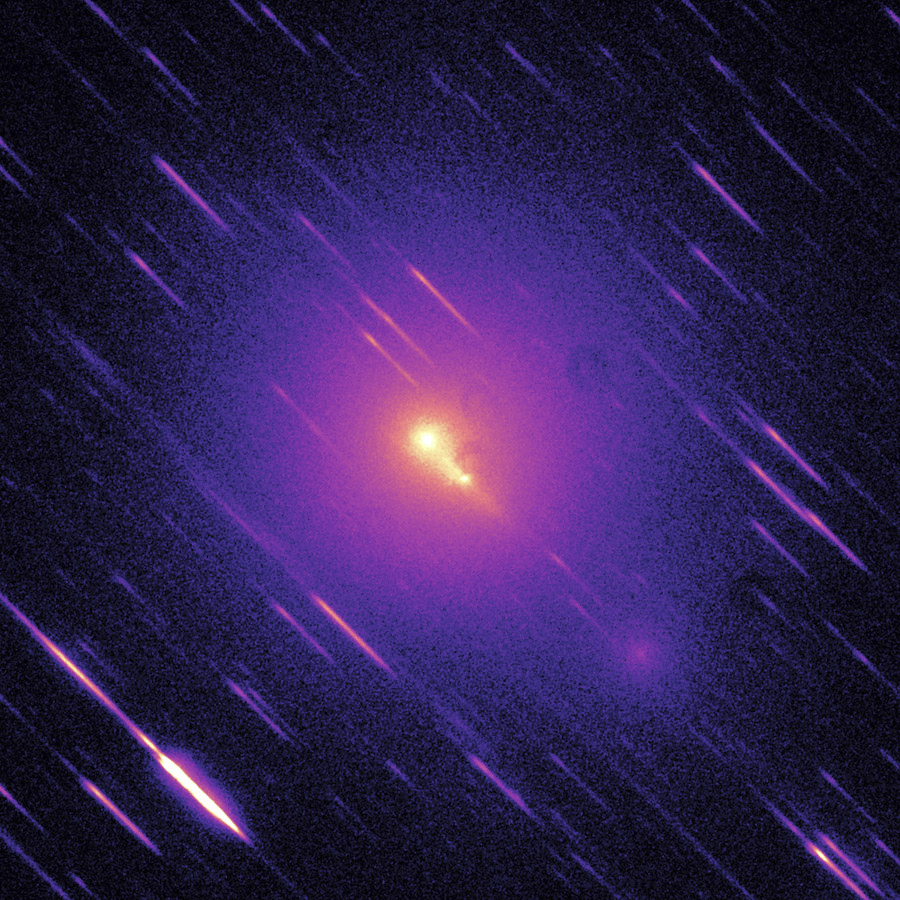
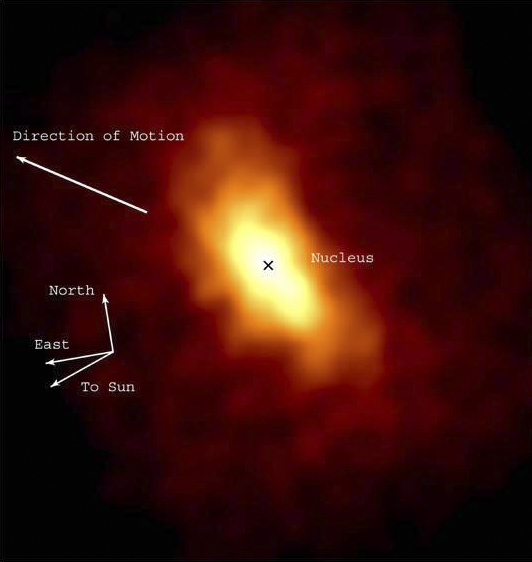 LEFT: Ultraviolet image of Comet Machholz C/2004 Q2 obtained by NASA’s GALEX spacecraft on March 1, 2005. The purple is due to emission from the hydroxyl (OH) molecule and the yellow is due to emission by the CS molecule. Courtesy NASA/JPL-CalTech/University of Washington/Jeffrey Morgenthaler. RIGHT: X-ray image of Comet LINEAR C/1999 S4, taken by the Chandra X-ray Observatory on July 14, 2000. Image Courtesy NASA.
LEFT: Ultraviolet image of Comet Machholz C/2004 Q2 obtained by NASA’s GALEX spacecraft on March 1, 2005. The purple is due to emission from the hydroxyl (OH) molecule and the yellow is due to emission by the CS molecule. Courtesy NASA/JPL-CalTech/University of Washington/Jeffrey Morgenthaler. RIGHT: X-ray image of Comet LINEAR C/1999 S4, taken by the Chandra X-ray Observatory on July 14, 2000. Image Courtesy NASA.
At this time there have apparently been no positive reports of gamma-rays from comets or asteroids, although since these are normally produced by very energetic processes involving atomic nuclei it would seem that these would not apply to the more benign environments involving the solar system’s “small bodies.” However, surprises often come in science, and it is perhaps not entirely out of the question that cometary and/or asteroidal gamma-rays may become an active area of investigation someday.
“Special Topics” archive
Ice and Stone 2020 home page
Earthrise Institute home page